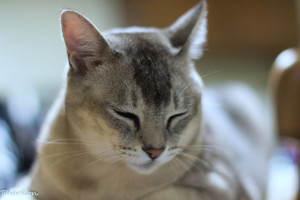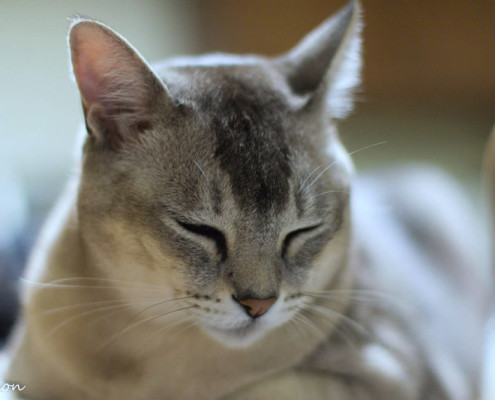Burmilla

Meoww!!
They are the best of both worlds: they can be playful, intelligent and very active but also can settle down after playtime and cuddle up to you, they are very affectionate.
In 5 Words
- Intelligent
- Playful
- Active
- Affectionate
- Friendly
Snapshot
Size: Medium
Weight: 8-10 lbs
Origin: United Kingdom
Life Span: 7-12 yrs.
Colour: Black, Blue, Chocolate, Lilac, Caramel, Beige, Apricot

Characteristics
Learn About the Burmilla
The Burmilla came about as the result of an accidental mating between a Lilac Burmese female (Bambino Lilac Faberge) & a Silver Chinchilla male (Jemari Sanquist). In 1981 Miranda Bickford-Smith (Astahazy Cattery) had purchased a Silver Chinchilla (Sanquist) as a pet for her husband. Faberge came into season & was isolated but a cleaner accidentally left Faberge’s door open & she was able to escape & pay a visit to Sanquist. The result of this mating produced 4 female kittens, all short haired & Black Shaded Silver in colour.
These stunning kittens had a spectacular temperament & there was much interest in the cat world in them. It wad decided to begin a controlled breeding programme.
In 1984 a Burmilla standard was agreed & the breed received official recognition in 1997.
Body
Burmillas are medium-sized with muscular yet elegant bodies, tending to weigh between 3–6 kg. Their distinguishing feature is their sparkling silver coat, and distinctive “make up” lining the nose, lips and eyes.
[edit]Head
Gently rounded top of head; medium width between ears; wide at eyebrow level and jaw hinge, tapering to a short, blunt wedge. The profile shows a gentle nose break. Tip of nose and chin should be in line. Chin is firm, with good depth.
Ears and Eyes
Medium to large, broad at base with slightly rounded tips. Ear set with slight forward tilt in profile. Eye shape is large; placed well apart at slight oblique setting; slightly curved upper; line angeled toward the nose, with a fuller curved lower line. Eye color luminous, any shade of green. Some allowance can be made for a gold or yellow tinge in kittens and young adults.
Coat
The Burmilla comes in two coat lengths, semi long hair and shorthair. Semi long hair Burmilla are known as Tiffanie in GCCF. The most common (standard) coat is the short-hair. This is a short, close-lying coat similar in appearance to the Burmese but with slightly padded feel due to the undercoat, it has a very soft, silky feel. The recessive longhair gene inherited from the Chinchilla can produce Longhair Burmilla. These cats have a semi-longhair coat following the lines of the body, with a soft, silky feel and a large plumed tail. The Shorthair gene is dominant, and where a cat receives one of each, the appearance will be Shorthair. Two Longhair Burmillas mated together will always produce Longhair kittens, while Shorthair matings depend on whether the Longhair genes are carried by the Shorthair parents.
Colours
The Burmilla have a variety of coat colours, including black, blue, brown, chocolate and lilac. Red, cream and tortoisehell (calico) varieties have been bred, these colours are not yet recognised by CCCA in Australia. All the Burmilla coat colours can be expressed in either Burmese expression, or full expression. The Burmilla is now recognised in Golden Shaded and Tipped in FIFe registries, but only Silver everywhere else. The Burmilla’s shading comes in two major coat patterns which relate to the depth of colour. These are Tipped and Shaded. Tipped Burmillas have a light dusting of colour (1/8 to 1/4 ) over the top of a silver or golden undercoat. In the case of Silvers, these cats can appear almost white. Shaded Burmillas have 1/4 – 1/2 as their colour giving the appearance of a mantle of colour over the back, shoulders and outside of the legs. Smoke pattern is not a Burmilla and in some registries is only allowed to be registered for breeding, not showing, they have almost all colour with only a faint pale base to each hair. The cats have nose leather coloured correspondingly to their coat colour and outlined in the matching coat shading colour. In addition their paw pads correspond to the coat colouring: Black Silver cats have black or very dark brown paw pads, Brown will have dark brown, Chocolate have pinkish brown, Blues have Blue-grey and Lilacs have Dove grey tinged with pink.
Colour Genetics
Since the Burmilla inherits its colour ranges from two different breeds, there is also the possibility of the entire Burmese spectrum of colours (black, Brown, Blue, Chocolate, Lilac and all the O gene range, both in Burmese Expression and in Full Expression. The inheritance of Silver also means that expression of colour can be variable, silver can darken and cool colour. However, since the Burmilla has a shaded coat pattern, it can be difficult to identify the various subtle shades of Burmese colouring, that are recessive to the Persian colouring.
The Burmilla is an outgoing, friendly and sociable cat that has inherited slightly modified characteristics from both of the original parents; it is not as noisy nor demanding as the Burmese, but is more adventurous and inquisitive than the Chinchilla
The Burmilla is set to become increasingly more popular because of its good looks and extremely good nature.
Burmillas are great with children. Combined with their low maintenance and wonderful disposition they make an ideal family pet.
The Burmilla appears to be a long-lived variety, with no health problems specific to the breed. In common with other cats, they need annual vaccination boosters against the common feline ailments of flu and enteritis, as well as against FelineLeukaemia if they go outdoors.
The Burmilla will eat most good quality proprietary brands of cat food, but will also enjoy treats of cooked chicken, ham and grated cheese, preferably shared with its humans if care is not taken! However, cows’ milk will probably give them a stomach upset, and a bowl of water should always be available. Their coats will not need much grooming, and stroking will normally remove any dead hairs, although a weekly combing will help to keep the coat in tiptop condition. The Burmilla loves its home comforts and will be perfectly happy living indoors with its adoring owners.






